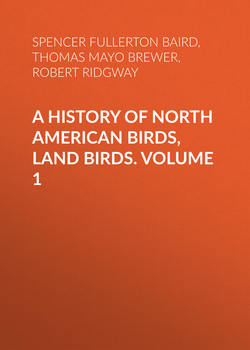Читать книгу A History of North American Birds, Land Birds. Volume 1 - Robert Ridgway - Страница 8
NORTH AMERICAN BIRDS
Family SYLVIIDÆ.—The Sylvias
ОглавлениеChar. Bill much shorter than head, slender, broad, and depressed at the base, distinctly notched and decurved at the tip. Culmen sharp-ridged at base. Frontal feathers reaching to the nostrils, which are oval, with membrane above, and overhung—not concealed—by a few bristles or by a feather. Rictal bristles extending beyond nostrils. Tarsi booted or scutellate. Basal joint of middle toe attached its whole length externally, half-way internally. Primaries ten; spurious primary about half the second, which is shorter than the seventh. Lateral toes equal.
The birds of this family are readily distinguished from the Paridæ by the slender bill, notched and decurved at tip; much bristled gape, sharp-ridged culmen, exposed oval nostrils, less adherent toes, etc. They are much smaller than the Turdidæ and Saxicolidæ, with much more slender, depressed bill, longer rictal bristles, etc. The short outer primary, with the primaries ten in number, distinguish them from the Sylvicolidæ.
The following synopsis will serve to characterize the American forms of their respective subfamilies. The species are all among the most diminutive in size with the exception of the Humming-Birds:—
A. Wings longer than the nearly even and emarginate tail. Scutellæ of tarsus scarcely or not at all appreciable. General color olivaceous above. No white on tail.
Nostrils naked. Scutellæ distinct on inner face of tarsus only. Head plain … Sylviinæ.
Nostrils overhung by bristly feathers. Scutellæ of tarsus not appreciable. Head with a colored central crest … Regulinæ.
B. Wings about equal to the graduated tail. Tarsal scutellæ distinct. Above bluish; tail with white spots or patches.
Nostrils uncovered. Head plain; either bluish or black above … Polioptilinæ.
